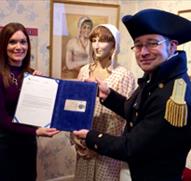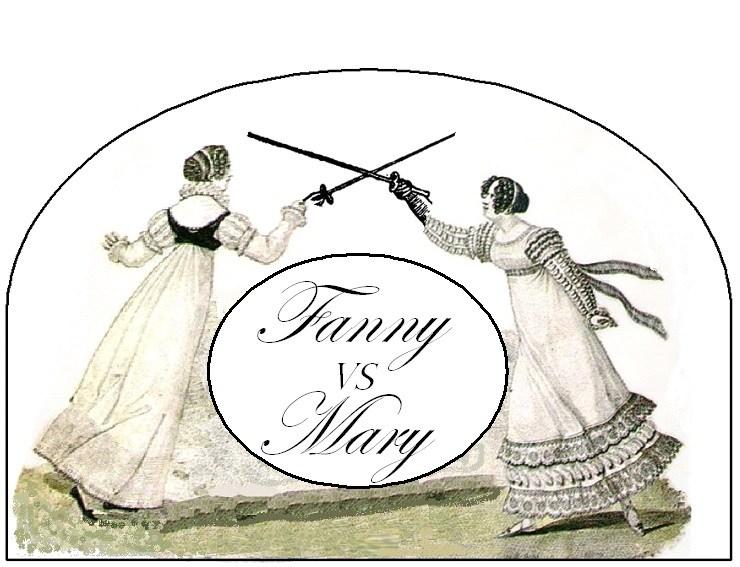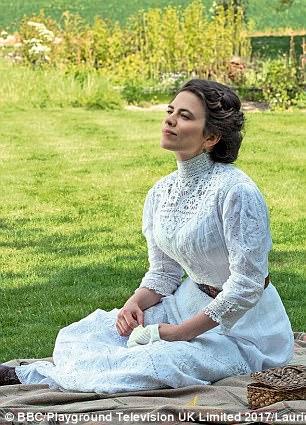Jane Austen News - Issue 91
What's the Jane Austen News this week?
In the Jane Austen News last week, we gave you a run-down of the week-long Fanny Price vs. Mary Crawford debate so far. The debate was a discussion between two Austen-inspired novelists, Kyra Kramer and Lona Manning, who were looking to answer who was the best heroine in Mansfield Park: Fanny Price, or Mary Crawford?
Lona was very definitely on Fanny Price's side, and Kyra was defending the honour and actions of Mary. That trend continued on days four and five...
Day Four
Question: Was Mary Crawford really Fanny Price's Friend?
Kyra: It wasn’t JUST as a conduit to Edmund that she became a friend to Fanny, and in time Mary began to actually love her. Remember that Mary rejoiced when Henry declared his love for Fanny, not only because Fanny would make him a sweet little wife, but because she valued Fanny.
Lona: I have been accusing Mary of being insincere, of always having a hidden agenda with the things she says. But you praise her for being an honest person. She knew that her brother planned to make a small 'hole in Fanny Price's heart' and she didn't stop him or warn Fanny, hmmmm? She deceived Fanny about the origin of the necklace, hmmmm? Where is the honesty you keep telling me about?
Day Five
Question: Who was the more shallow in character? Mary Crawford or Fanny Price?
Kyra: Fanny Price was much more aware of social status and money than she is commonly thought of as being. Fanny clearly preferred living with her moneyed relatives in Mansfield Park rather than with her lower-class parents. It is Mansfield Park that she thinks of as “home”, and she appears to love her rich relatives more than her parents. She is much more concerned about Aunt Bertram needing her than she is with staying to help her own mother. In fact, sweet, noble, unworldly little Fanny is willing to put up with a whole lot of crap – being her aunt’s dogsbody and unpaid companion, getting affection from no one but Edmund Bertram, being emotionally and verbally abused by Mrs. Norris – just to live in a mansion and walk in fancy shrubbery and wallow in general poshness. She sure doesn’t enjoy living like the lower class, with just one shabby servant and vile housing!
Lona: It’s so difficult for us to imagine what it would be like to be so genteel that we couldn’t cook a meal or clean a household. But keeping house was a much rougher and dirtier business back then. Austen stipulates that Fanny was too frail to live in that environment. However, Fanny really loved books and the education she had received, more than the grandeur.
A hotly fought debate was most definitely had. Though, as with all good debates, the opinions of both were taken into account by the other party and it was a good clean argument. Although no clear winner emerged, a lot of salient points were raised and a good discussion was had by all. Links to each day of debates can be found at the end of this edition of the Jane Austen News.
far. The debate was a discussion between two Austen-inspired novelists, Kyra Kramer and Lona Manning, who were looking to answer who was the best heroine in Mansfield Park: Fanny Price, or Mary Crawford?
Lona was very definitely on Fanny Price's side, and Kyra was defending the honour and actions of Mary. That trend continued on days four and five...
Day Four
Question: Was Mary Crawford really Fanny Price's Friend?
Kyra: It wasn’t JUST as a conduit to Edmund that she became a friend to Fanny, and in time Mary began to actually love her. Remember that Mary rejoiced when Henry declared his love for Fanny, not only because Fanny would make him a sweet little wife, but because she valued Fanny.
Lona: I have been accusing Mary of being insincere, of always having a hidden agenda with the things she says. But you praise her for being an honest person. She knew that her brother planned to make a small 'hole in Fanny Price's heart' and she didn't stop him or warn Fanny, hmmmm? She deceived Fanny about the origin of the necklace, hmmmm? Where is the honesty you keep telling me about?
Day Five
Question: Who was the more shallow in character? Mary Crawford or Fanny Price?
Kyra: Fanny Price was much more aware of social status and money than she is commonly thought of as being. Fanny clearly preferred living with her moneyed relatives in Mansfield Park rather than with her lower-class parents. It is Mansfield Park that she thinks of as “home”, and she appears to love her rich relatives more than her parents. She is much more concerned about Aunt Bertram needing her than she is with staying to help her own mother. In fact, sweet, noble, unworldly little Fanny is willing to put up with a whole lot of crap – being her aunt’s dogsbody and unpaid companion, getting affection from no one but Edmund Bertram, being emotionally and verbally abused by Mrs. Norris – just to live in a mansion and walk in fancy shrubbery and wallow in general poshness. She sure doesn’t enjoy living like the lower class, with just one shabby servant and vile housing!
Lona: It’s so difficult for us to imagine what it would be like to be so genteel that we couldn’t cook a meal or clean a household. But keeping house was a much rougher and dirtier business back then. Austen stipulates that Fanny was too frail to live in that environment. However, Fanny really loved books and the education she had received, more than the grandeur.
A hotly fought debate was most definitely had. Though, as with all good debates, the opinions of both were taken into account by the other party and it was a good clean argument. Although no clear winner emerged, a lot of salient points were raised and a good discussion was had by all. Links to each day of debates can be found at the end of this edition of the Jane Austen News.
 as Longbourn for the BBC 1995 adaptation of Pride and Prejudice, had gone on the market - with a hefty price-tag of £9 million. Well, despite its film credentials, the house is still up for sale (with a new lower price of £7.75 million), and is, it seems, being considered by Prince Harry and his girlfriend actress Meghan Markle, as their potential new home.
Meghan is due to move to the UK from Toronto when she finishes filming her last season of Suits next month, so she and Harry have been house hunting. An estate agent local to Luckington Court in the Cotswolds confirmed that the couple spent two hours looking at Luckington, though they haven't made an offer yet. Having said that, according to the Express, a source close to Harry acknowledged that Prince Harry "loved" Luckington, which is only eight miles from Prince Charles's home, Highgrove.
as Longbourn for the BBC 1995 adaptation of Pride and Prejudice, had gone on the market - with a hefty price-tag of £9 million. Well, despite its film credentials, the house is still up for sale (with a new lower price of £7.75 million), and is, it seems, being considered by Prince Harry and his girlfriend actress Meghan Markle, as their potential new home.
Meghan is due to move to the UK from Toronto when she finishes filming her last season of Suits next month, so she and Harry have been house hunting. An estate agent local to Luckington Court in the Cotswolds confirmed that the couple spent two hours looking at Luckington, though they haven't made an offer yet. Having said that, according to the Express, a source close to Harry acknowledged that Prince Harry "loved" Luckington, which is only eight miles from Prince Charles's home, Highgrove.
They both definitely want to be in the Cotswolds, they prefer it to Norfolk [where William and Kate have a house] and they are looking at a shortlist of properties – not too big or too showy, but obviously with the need for privacy and staff accommodation.
Jane Austen has often been seen as a novelist whose books are only really for women. Didn't she only write soppy
 romances after all? No! Of course not! But try telling that to your average male youth. Well, one teacher in York in South Carolina has done just that - with fantastic results.
Kay McSpadden has a class of 16 boys and 5 girls who all struggle in English. Some have had run-ins with the law, some are in special education classes, some are dedicated 'jock' types, and some miss school when deer season opens. Her class is not the easiest one when seen on paper. However this didn't stop McSpadden from introducing them to Austen.
romances after all? No! Of course not! But try telling that to your average male youth. Well, one teacher in York in South Carolina has done just that - with fantastic results.
Kay McSpadden has a class of 16 boys and 5 girls who all struggle in English. Some have had run-ins with the law, some are in special education classes, some are dedicated 'jock' types, and some miss school when deer season opens. Her class is not the easiest one when seen on paper. However this didn't stop McSpadden from introducing them to Austen.
Austen’s prose is difficult even for our honors students, so my non-college bound students read excerpts and watched Ang Lee’s “Sense and Sensibility” and Joe Wright’s “Pride and Prejudice,” two film adaptations of the novels. The class was hooked immediately. “Promise me this is going to end up happy,” one boy dressed in camouflage said at the end of the first day. It is a truth universally acknowledged that boys generally prefer “boy stories”—adventures starring male protagonists. I had worried that my students would tune out a woman’s voice or resist seeing the world through a woman’s point of view. But like most “truths universally acknowledged,” that turned out to be an assumption that didn’t play out in reality. Without my saying a word, they connected the dots from Austen’s stories to the current accounts of sexual harassment and misogyny dominating the news.Proof that Austen really is still relevant in our modern times, and that her novels are for everyone! Except....
 .....Despite that real success story from South Carolina, some are calling for classics, like the novels of Jane Austen, to be removed from school syllabi.
The argument is that classic books mirror the time in which they were written, and so, can help prejudices to live on. For example, Harper Lee's To Kill A Mockingbird came under fire in many schools, and in Biloxi, Mississippi, it was removed from the junior high required reading list because of the derogatory racial themes and terms which came up in the book. (Later it was put back on the list but students have to bring in a signed permission slip from parents to be able to read it).
Harper Lee's book isn't the only one that's been called into question though. Pride and Prejudice has been drawn into the fray, with some saying that it reinforces gender roles and insensitive stereotypes of women's dependence upon men for money and status. Incredible. You need only look just beneath the surface of Jane's novels, a deep analysis isn't even required to see that she is deriding such views. She knew how wrong it was that women in society weren't given power over their own fates. Surely even a cursory reading in school would make that clear?
Well, to end on a positive note, a (small) upside to the furore could be that making Jane's novels a bit taboo might, just might, tempt more students to read them who might not otherwise...?
.....Despite that real success story from South Carolina, some are calling for classics, like the novels of Jane Austen, to be removed from school syllabi.
The argument is that classic books mirror the time in which they were written, and so, can help prejudices to live on. For example, Harper Lee's To Kill A Mockingbird came under fire in many schools, and in Biloxi, Mississippi, it was removed from the junior high required reading list because of the derogatory racial themes and terms which came up in the book. (Later it was put back on the list but students have to bring in a signed permission slip from parents to be able to read it).
Harper Lee's book isn't the only one that's been called into question though. Pride and Prejudice has been drawn into the fray, with some saying that it reinforces gender roles and insensitive stereotypes of women's dependence upon men for money and status. Incredible. You need only look just beneath the surface of Jane's novels, a deep analysis isn't even required to see that she is deriding such views. She knew how wrong it was that women in society weren't given power over their own fates. Surely even a cursory reading in school would make that clear?
Well, to end on a positive note, a (small) upside to the furore could be that making Jane's novels a bit taboo might, just might, tempt more students to read them who might not otherwise...?
Our Jane Austen Centre received a welcome visit from a representative of the Bank of England on Monday. Amanda Stratton arrived from Threadneedle Street bearing a commemorative £10 note presentation pack from Mark Carney, the Bank of England Governor.
 The serial number of the note is very special - AA01 001775, the year of Jane Austen's birth.
The portrait on the note is based on an engraving by William Hone Lizars, who fashioned his artwork on a sketch by Jane's sister Cassandra.
'We are delighted to have been awarded what we consider to be the ultimate serial number on a £10 note - 1775. When we put it on display it will be of huge interest to our visitors,' said General Manager Paul Crossey.
The note and presentation pack will be displayed at the Centre from today! (1st of November)
The serial number of the note is very special - AA01 001775, the year of Jane Austen's birth.
The portrait on the note is based on an engraving by William Hone Lizars, who fashioned his artwork on a sketch by Jane's sister Cassandra.
'We are delighted to have been awarded what we consider to be the ultimate serial number on a £10 note - 1775. When we put it on display it will be of huge interest to our visitors,' said General Manager Paul Crossey.
The note and presentation pack will be displayed at the Centre from today! (1st of November)
 Jane Austen News is our weekly compilation of stories about or related to Jane Austen. Here we will feature a variety of items, including craft tutorials, reviews, news stories, articles and photos from around the world. If you’d like to include your story, please contact us with a press release or summary, along with a link. You can also submit unique articles for publication in our Jane Austen Online Magazine.
Don’t miss our latest news – become a Jane Austen Member and receive a digest of stories, articles and news every week. You will also be able to access our online Magazine with over 1000 articles, test your knowledge with our weekly quiz and get offers on our Online Giftshop. Plus new members get an exclusive 10% off voucher to use in the Online Giftshop.
Jane Austen News is our weekly compilation of stories about or related to Jane Austen. Here we will feature a variety of items, including craft tutorials, reviews, news stories, articles and photos from around the world. If you’d like to include your story, please contact us with a press release or summary, along with a link. You can also submit unique articles for publication in our Jane Austen Online Magazine.
Don’t miss our latest news – become a Jane Austen Member and receive a digest of stories, articles and news every week. You will also be able to access our online Magazine with over 1000 articles, test your knowledge with our weekly quiz and get offers on our Online Giftshop. Plus new members get an exclusive 10% off voucher to use in the Online Giftshop.



1 comment
Thanks so much for sharing the Fanny vs Mary debate! Kyra Kramer and I hope that the debate raised appreciation for and interest in Mansfield Park — Austen’s nuanced, subtle masterpiece.
Anonymous
Leave a comment
This site is protected by hCaptcha and the hCaptcha Privacy Policy and Terms of Service apply.